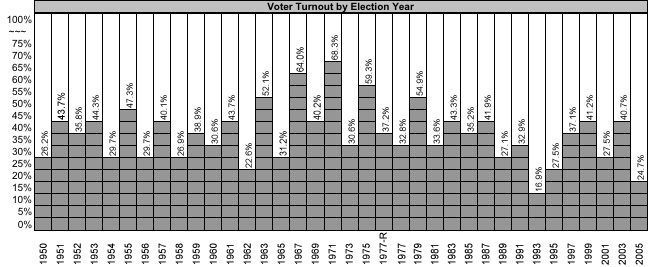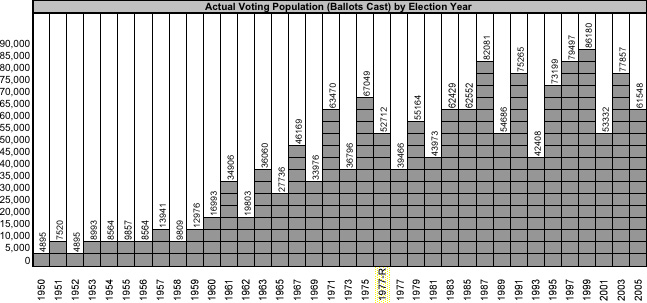Elections Past Summary: 1950 - 2005/7
Looking at the past half century of voting records some electoral problems come into better focus. Like an observer in a chess match, patterns become more clear with a more distanced perspective. Tucson's elective relevancy problem has existed for a long time and is much older than our unbridled growth spurt that has existed since the late 1950's. Whether the true culprit is the connection to Tucson
of those who move here or the perceived importance of city government is unclear, but the longevity of the problem is verifiable.

In the graph (above) you can see that our voter percentiles tend to hover 20s and 30s during non-mayoral mid-town election cycles. That is where Wards 3, 5 and 6 elect City Council without the mayor. During mayoral elections, with Wards 1, 2 and 4 the percentile hovers in the 30s and 40s. That's an average 10% bump for the Mayor. There is an exception during election in 1960s and 70s when mayoral election got an average 30% bump and the discrepancy between mid-town and mayoral elections soared.

Considering the raw number of ballots (above) it is evident that the disparity between mid-town and mayoral elections remain, but the number of ballots cast increases. This reflects the rapid growth Tucson has seen since the late 1950s.

Considering the voting population available during our elections (above) the disparity between mid-town and mayoral election remain, but the number of voters increases. This trend reflects the rapid growth Tucson has seen since the late 1950s.

The graph (above) shows elected majority distribution, by ward, of the Mayor and Council through the past 57 years. It is important to note that the 1950s through the '70s could be defined as a see-saw transfer of authority between the two dominant political parties. Afterwards and for the past 30 years Democratic Party officials have had a firm grip on the council. It is also important to note how often each party's success depended upon general elections with no major party opposition or elections lost within the ward but won at-large. Also, comparing these graphs you might note that the dominant party in Tucson, the Democratic Party, has done exceptionally well during elections with low turnout as do most majority parties in other regions of the country.
Throughout the years three out of five mayors have been Republicans. The recall of 1977 is another and more sordid matter.
You might also note that enough seats are available in the 2007 election to change the majority.



